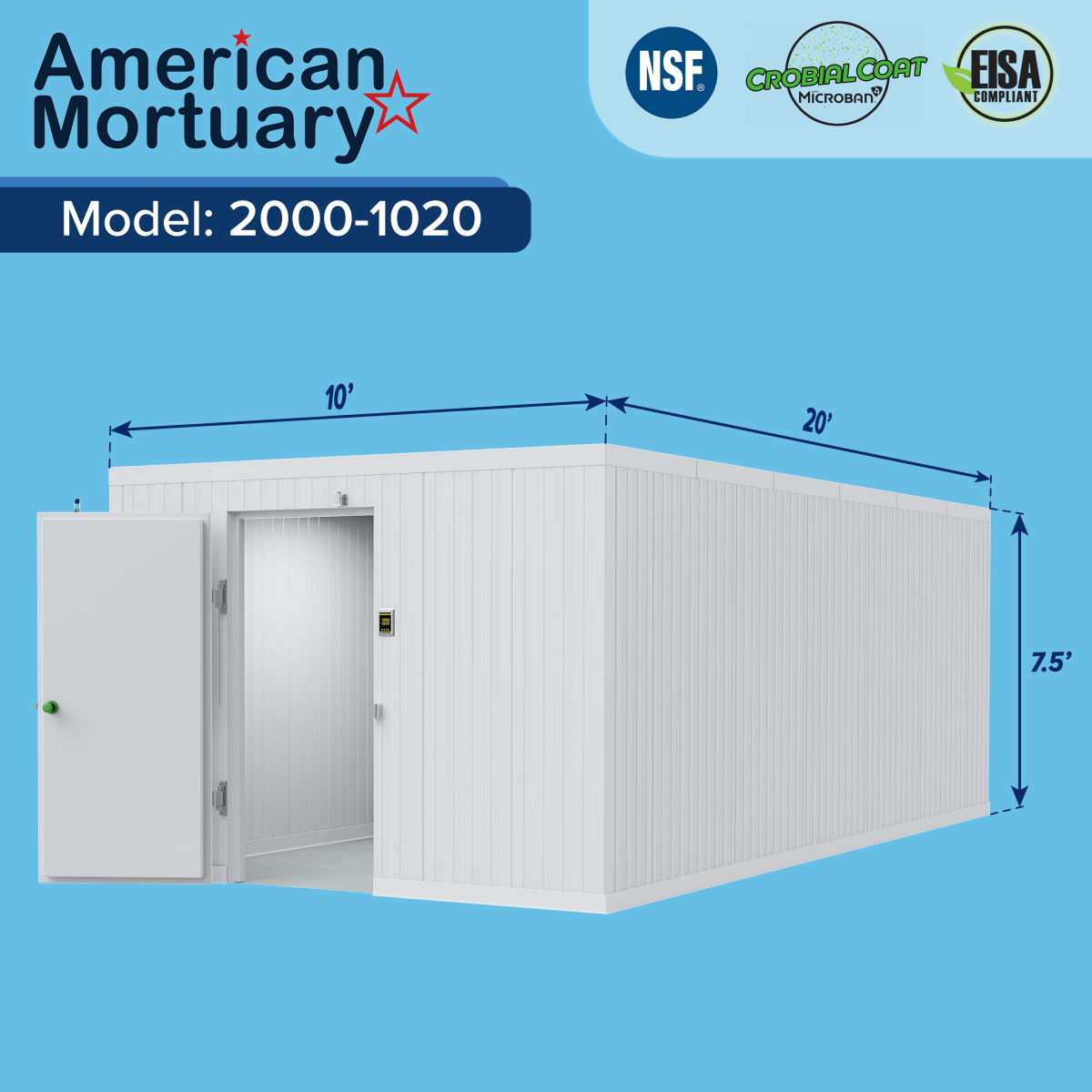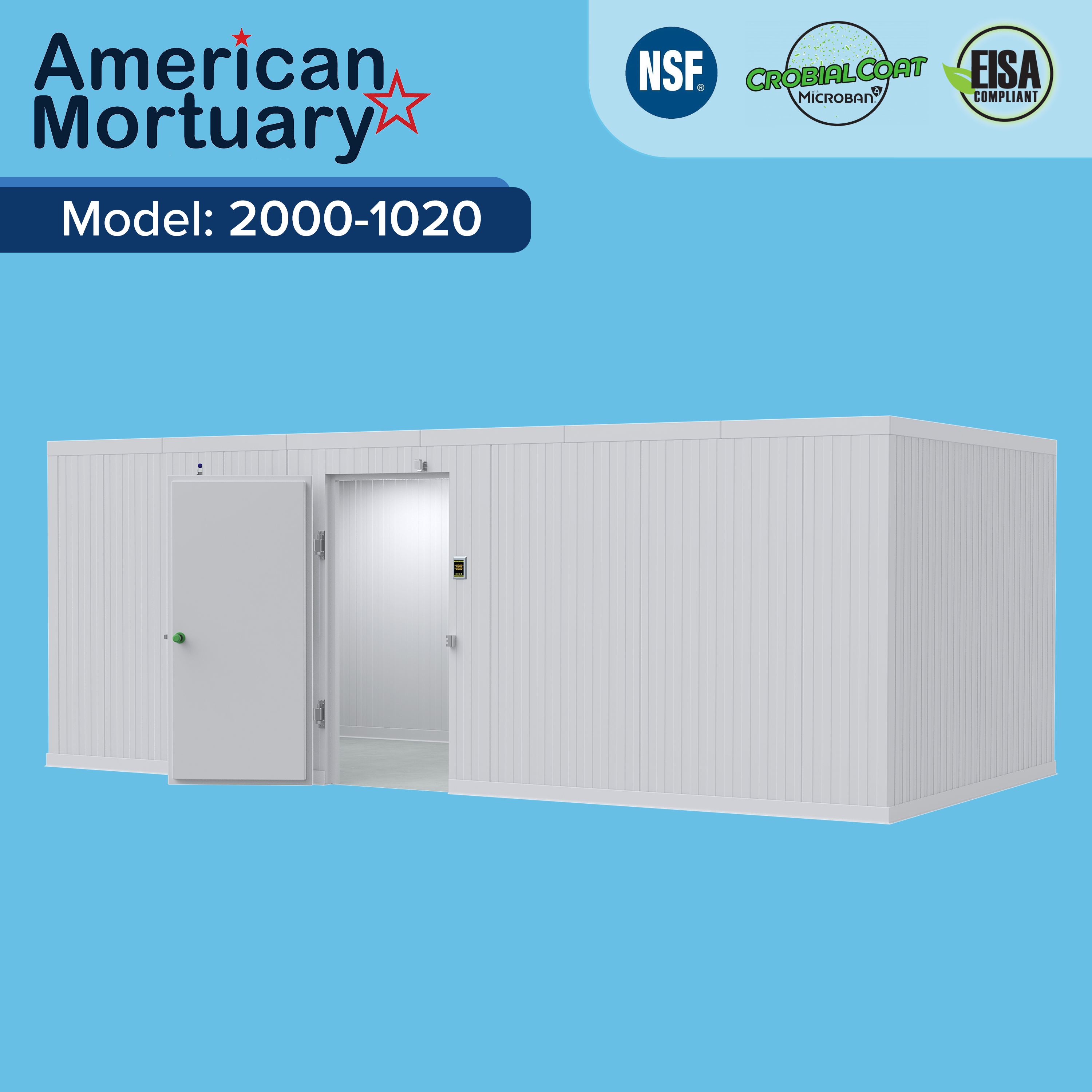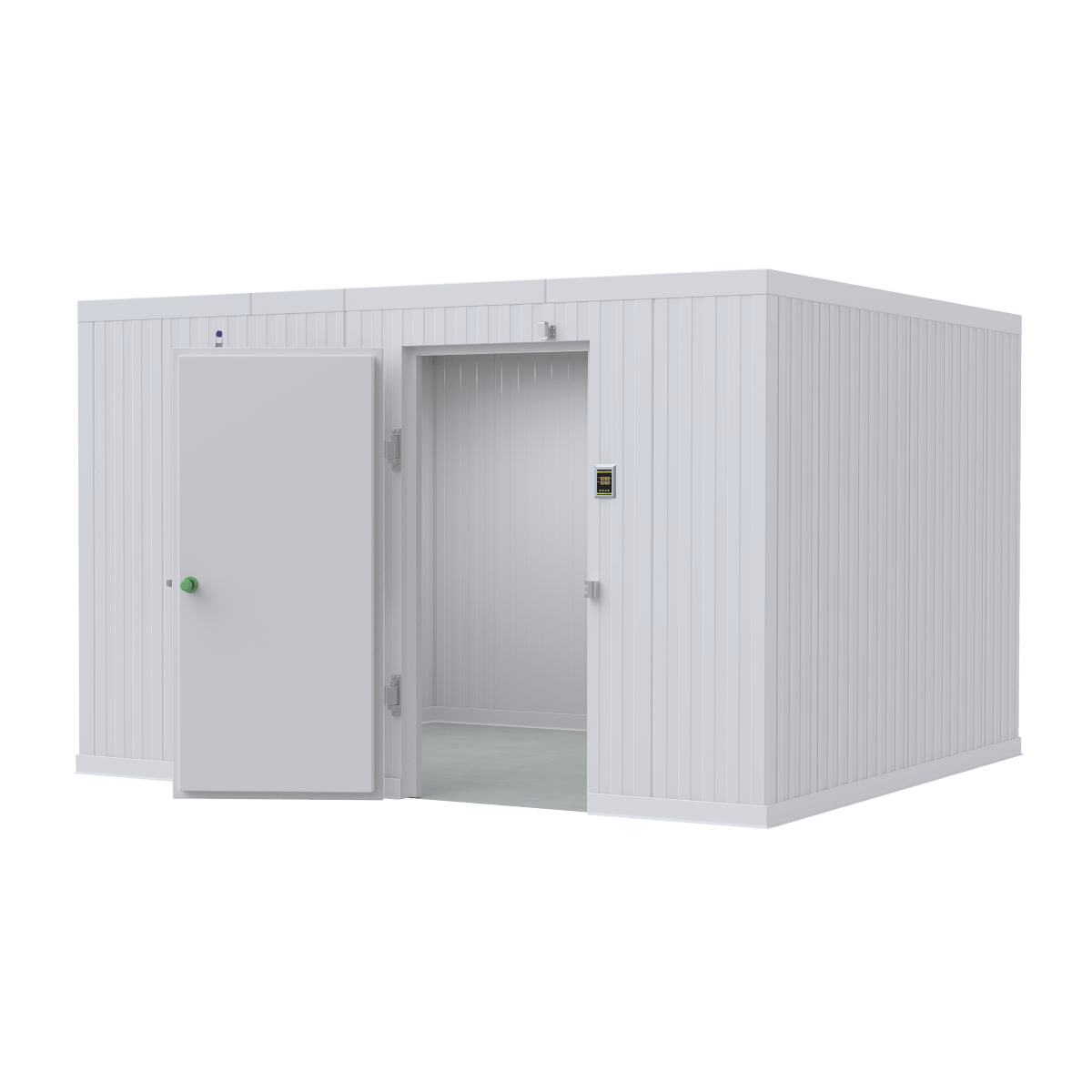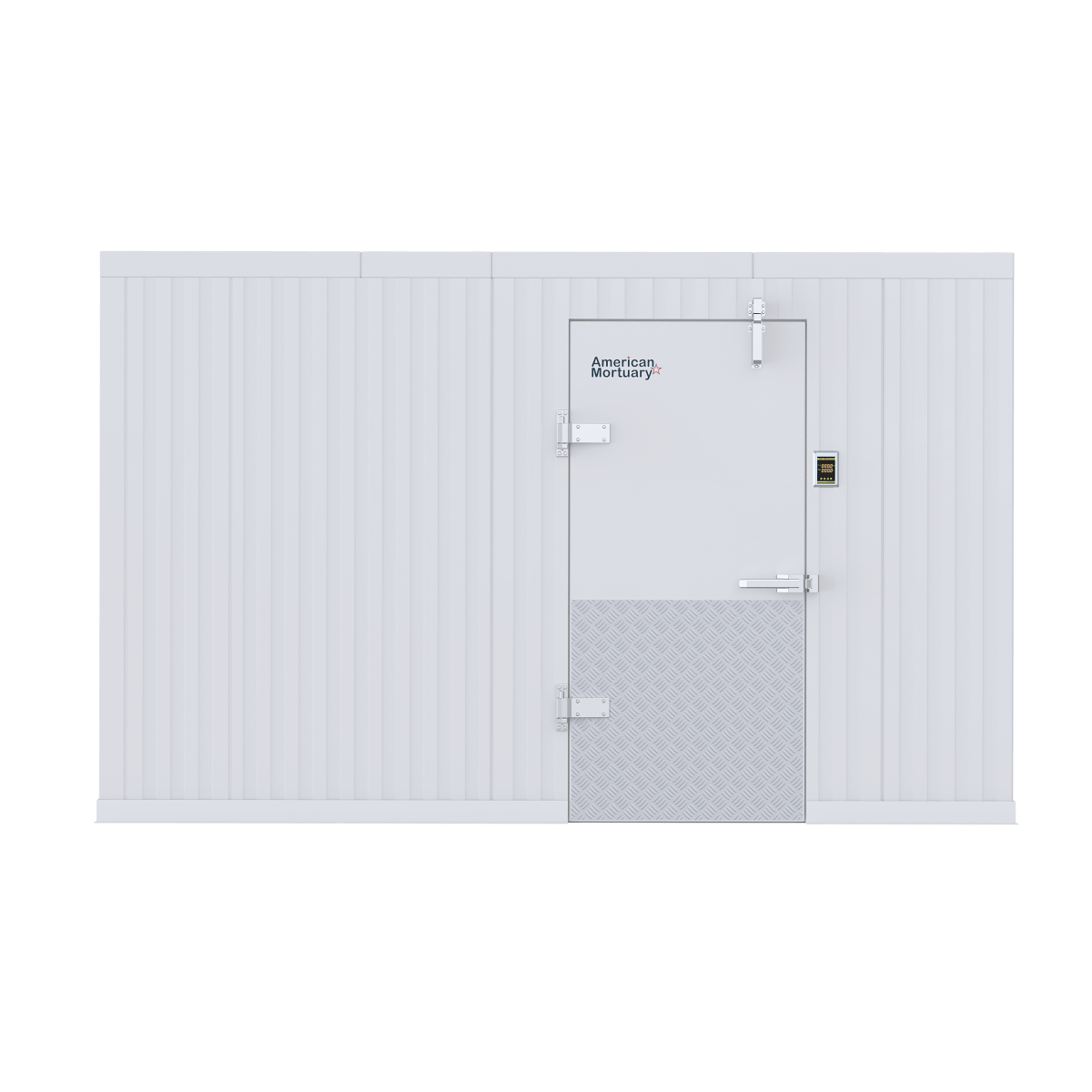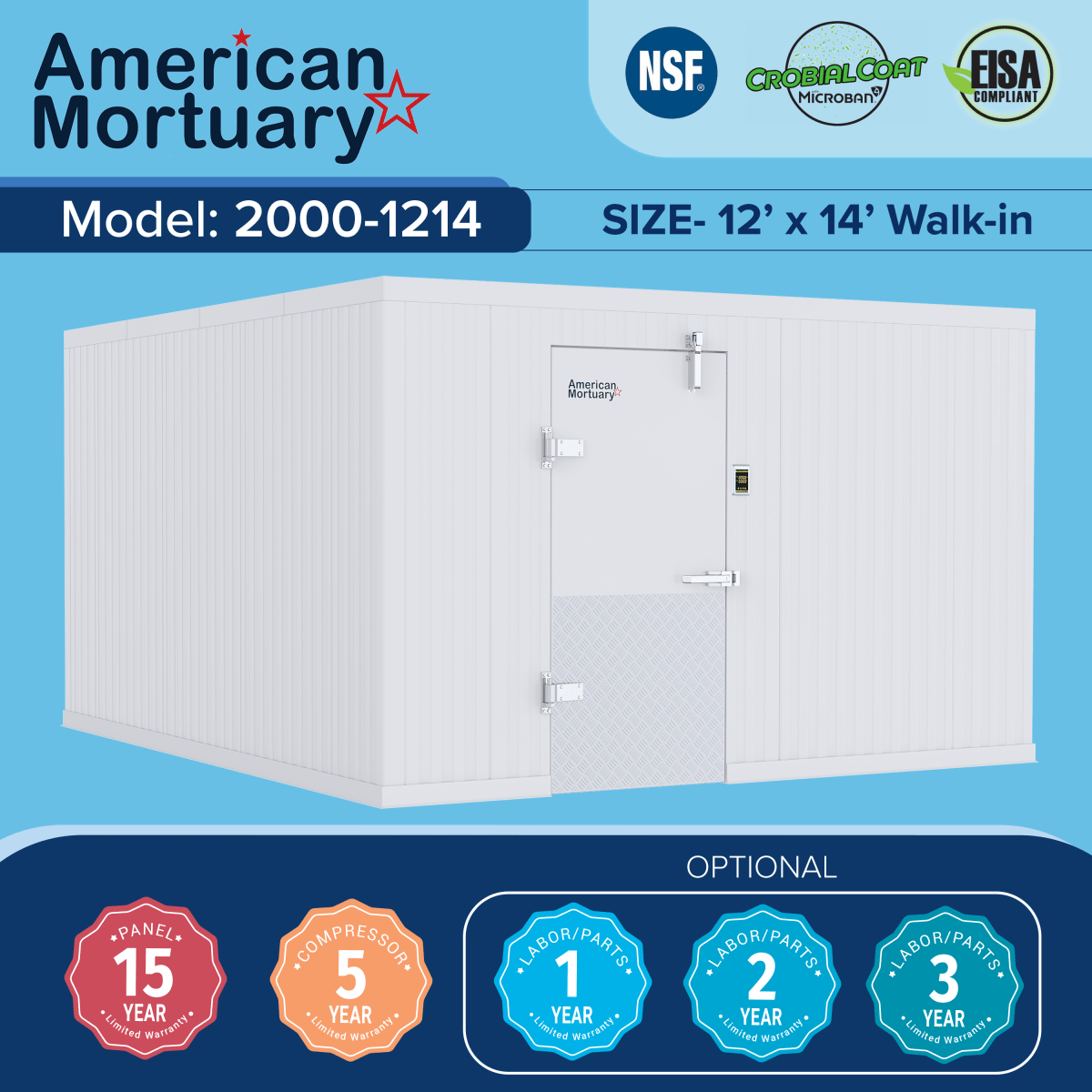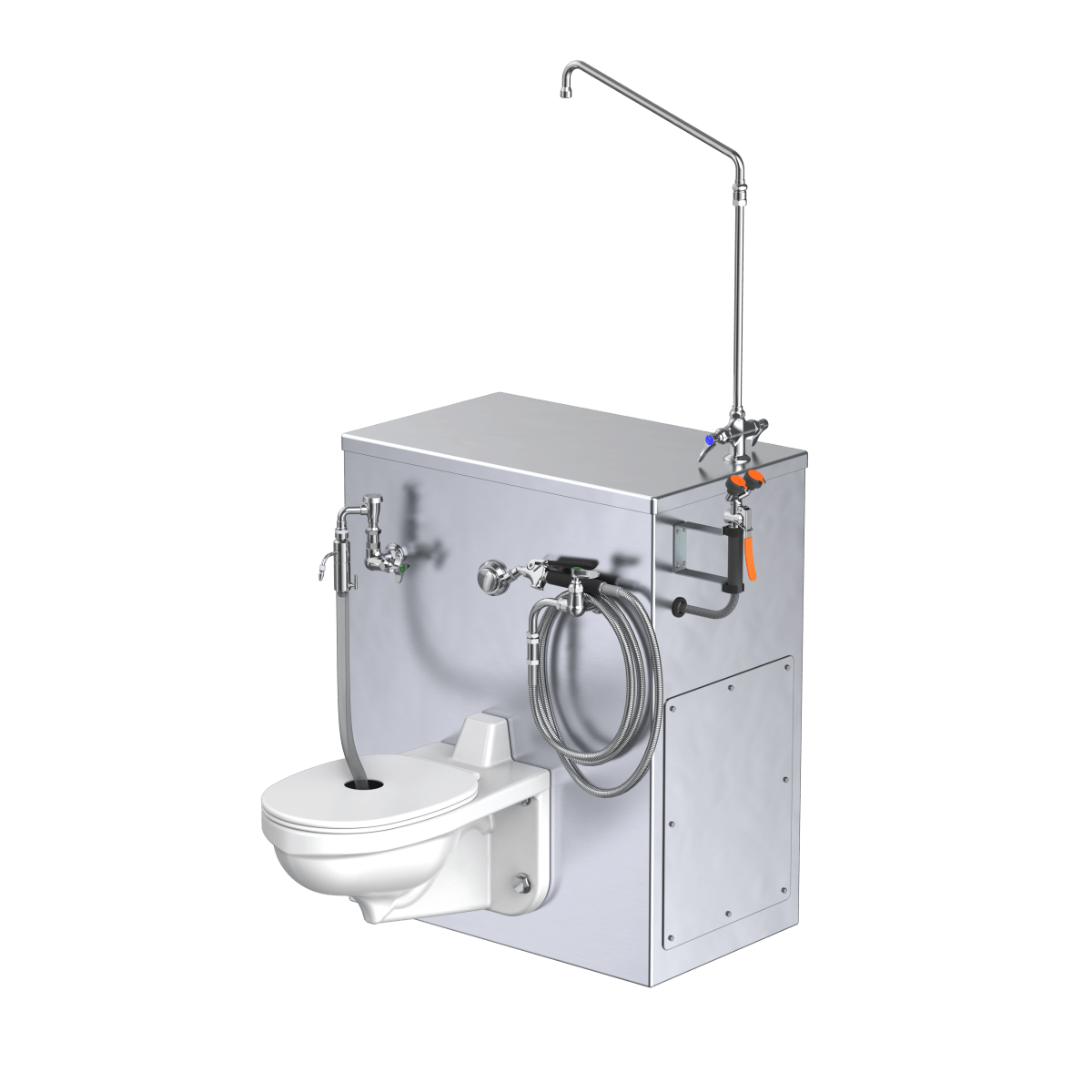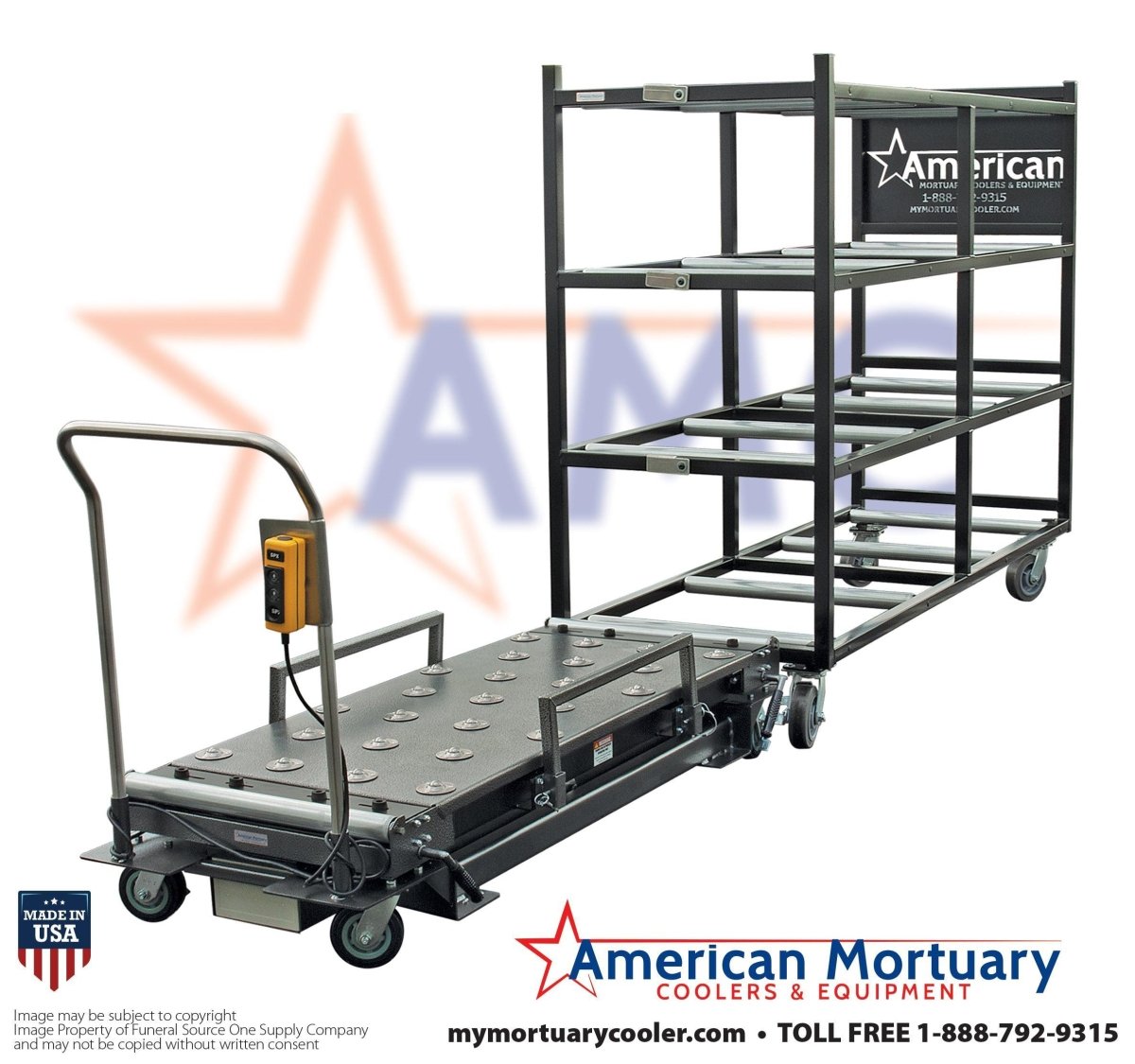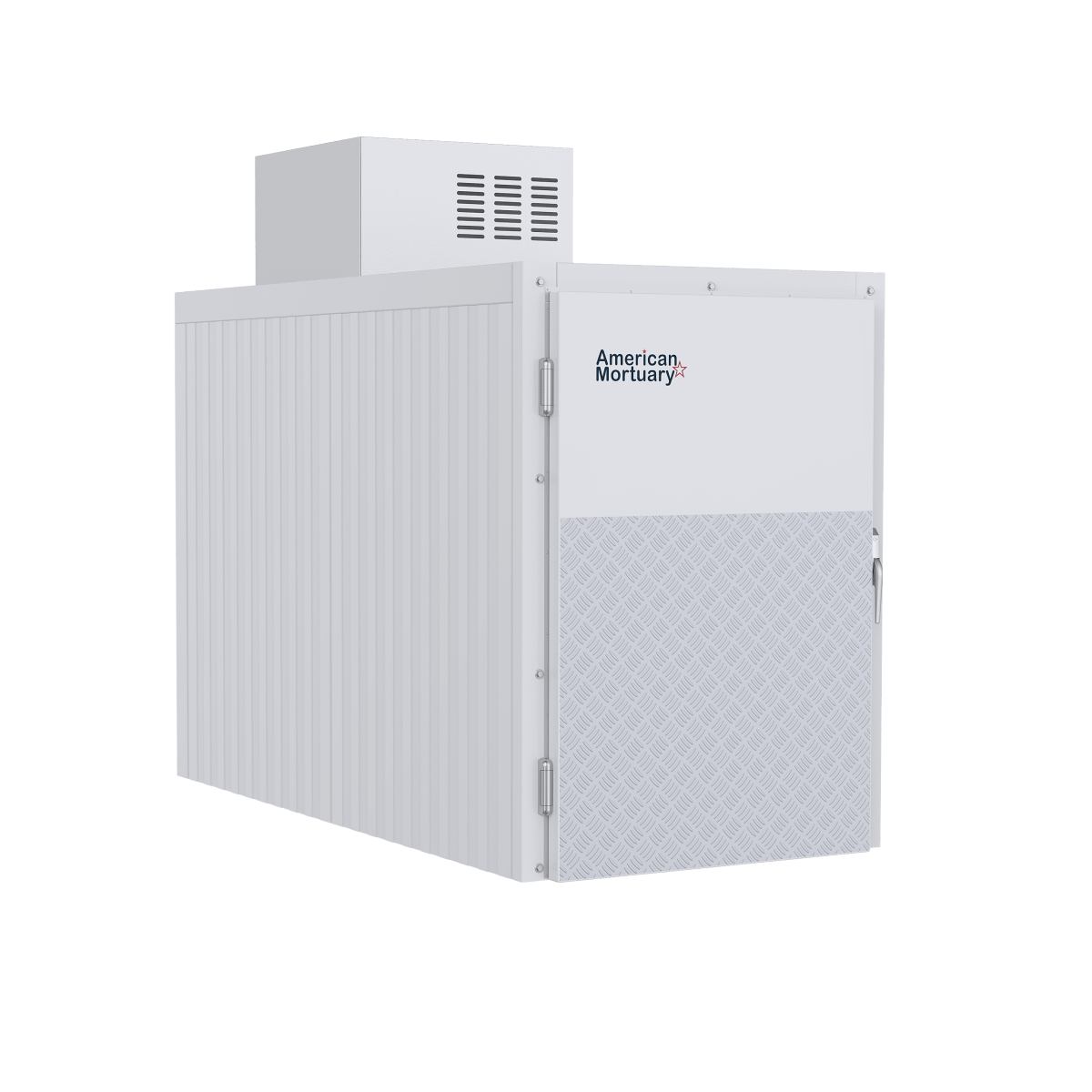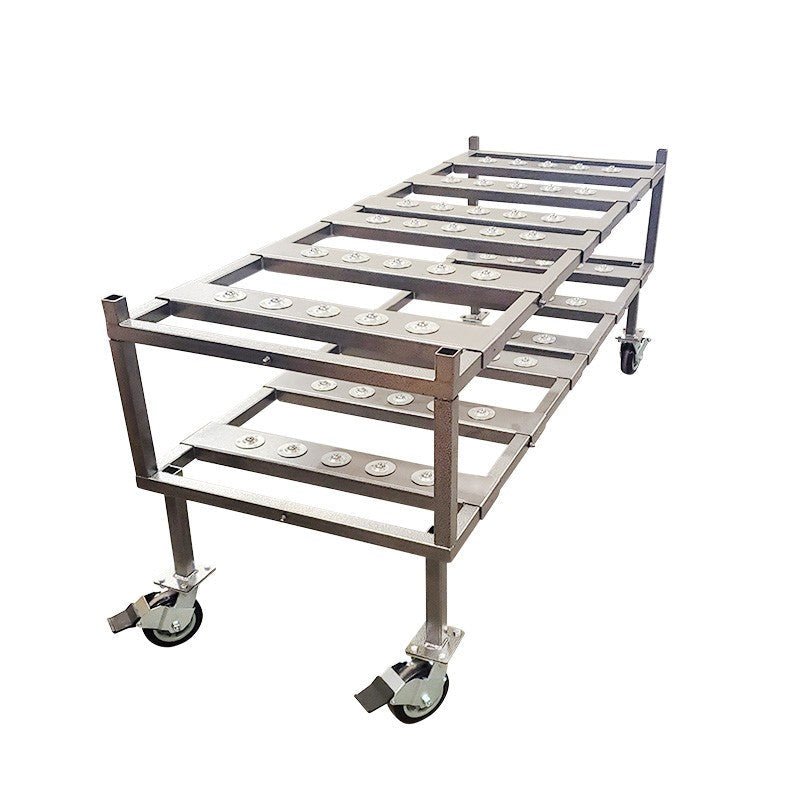Finding the Right Walk-In Mortuary Cooler Size for Your Facility
Choosing the perfect Walk-In Mortuary Cooler Size feels a bit like finding Goldilocks' "just right" solution. Too small, and you'll face uncomfortable capacity issues during busy periods. Too large, and you're essentially cooling empty space while watching your utility bills climb.
At American Mortuary Coolers, we've guided countless funeral homes and medical facilities through this important decision. Our standard sizes range from cozy 8'×8' units for smaller operations to expansive 24'×30' spaces for larger facilities with substantial caseloads.
Here's a helpful reference chart of our most popular Walk-In Mortuary Cooler Sizes:
| Size (W×L) | Square Footage | Body Capacity |
|---|---|---|
| 8' × 8' | 64 sq. ft. | 9-12 bodies |
| 10' × 15' | 150 sq. ft. | 20-25 bodies |
| 12' × 20' | 240 sq. ft. | 30-36 bodies |
| 20' × 20' | 400 sq. ft. | 45-48 bodies |
| 24' × 30' | 720 sq. ft. | 60+ bodies |
Unlike standard commercial refrigeration, mortuary walk-ins have unique requirements. They need to maintain precise temperatures between 36-39°F, accommodate specialized racking systems, and ensure proper air circulation around each decedent. The right size isn't just about fitting bodies—it's about creating a dignified, efficient workspace that serves families during their most difficult moments.
Your ideal size depends on several practical factors: your average monthly caseload, typical holding period (how many days you keep decedents), available floor space, and of course, your budget. We've found that many funeral directors appreciate having a small buffer of extra capacity—nobody wants to explain to a family that there's "no room at the inn" during a busy holiday weekend.

Based in Tennessee but serving funeral homes across the continental United States, we understand that each facility has unique needs. Some rural funeral homes might handle fewer cases but need longer holding periods due to crematory scheduling, while urban facilities might process more decedents with shorter stays.
The difference between a well-sized cooler and an inadequate one becomes especially apparent during unexpected surges or seasonal variations. That's why we recommend analyzing your busiest months from the past few years, not just your average caseload, when making this decision.
If you're still uncertain about which Walk-In Mortuary Cooler Size is right for your facility, you might find our detailed guide helpful: Best Walk-In Cooler Options Available. Or better yet, let's have a conversation about your specific needs—because when it comes to mortuary refrigeration, one size definitely doesn't fit all.
What Sets Walk-In Mortuary Coolers Apart?
When it comes to dignified preservation of the deceased, walk-in mortuary coolers stand in a class of their own. These specialized units might look similar to commercial refrigerators at first glance, but they're thoughtfully engineered for the unique needs of funeral homes and hospitals.
"Dependability, functionality, and longevity are essential for mortuary coolers and successful mortuary business operations," our engineering team at American Mortuary Coolers often says. This philosophy guides every unit we build across our nationwide network.
What truly distinguishes Walk-In Mortuary Cooler Sizes is their person-entry design. Unlike smaller options, these coolers allow staff to physically enter the refrigerated space, creating a more respectful and efficient workflow. They maintain precise temperatures between 36-39°F (2-4°C) – the sweet spot for preservation without tissue freezing – using carefully designed modular panels with superior sanitation features.
Walk-In vs Body Box Overview
Body boxes represent the compact end of mortuary refrigeration solutions. While they serve an important purpose, they differ dramatically from walk-ins in several key aspects.
Mobility is the body box's primary advantage – many feature casters for easy repositioning. They offer plug-and-play convenience, typically connecting to standard outlets, and their limited capacity (usually 1-6 decedents) makes them suitable for facilities with extreme space constraints.
However, this limited capacity quickly becomes problematic for growing operations. As one funeral director from Southern California shared with us: "With the 8'×12' CoolBot Walk-In Cooler for about $5K, I've got capacity for twenty-five people. I've become the largest refrigeration facility for human remains in Southern California because of CoolBot. It is literally a game changer in the funeral industry."
This real-world experience highlights the substantial difference between these options. While a typical 3-body box measures around 57.5" wide × 8' long × 8' high, a similarly-sized walk-in can accommodate three times as many decedents through efficient racking systems.
Walk-In vs Commercial Food Walk-Ins
Though they might look similar from the outside, mortuary walk-ins and food-service coolers serve fundamentally different purposes, with several critical distinctions:
Specialized rack compatibility in mortuary units accommodates human remains on trays or cots, unlike food shelving systems. Humidity control is precisely calibrated for preservation rather than food freshness, while health-code specifications meet the unique requirements for human remains storage.
Beyond these differences, mortuary walk-ins feature wider doors (40"-48") specifically designed for stretchers and body boards. The flooring is reinforced to support the concentrated weight of loaded body racks, and specialized insulation with R-values from 28 to 43 ensures temperature stability even during frequent door openings.
Most importantly, mortuary coolers incorporate thoughtful sanitation features – floor drains, antimicrobial surfaces, and specialized cleaning provisions – that maintain the dignity of the deceased while protecting public health.
For more detailed comparisons between various cold storage options, check out our More info about mortuary cooler types guide.
Standard Walk-In Mortuary Cooler Sizes & Capacity Chart
When planning for a walk-in mortuary cooler, understanding the relationship between external dimensions, internal usable space, and body capacity is crucial. Walk-In Mortuary Cooler Sizes range from compact units suitable for small funeral homes to expansive installations for medical examiners' offices and high-volume facilities.

I've helped hundreds of funeral directors find their perfect cooler size, and I'm always surprised by how much thought goes into this decision. It's not just about numbers—it's about creating a dignified space that serves families during difficult times. Here's a helpful chart we've put together at American Mortuary Coolers that shows our most common configurations:
| External Dimensions | Internal Dimensions | Panel Thickness | Body Capacity | Typical Application |
|---|---|---|---|---|
| 8' × 8' × 7'4" | 7'4" × 7'4" × 6'10" | 4" (R-32) | 9-12 bodies | Small funeral homes |
| 10' × 10' × 7'4" | 9'4" × 9'4" × 6'10" | 4" (R-32) | 15-18 bodies | Medium funeral homes |
| 10' × 15' × 7'4" | 9'4" × 14'4" × 6'10" | 4" (R-32) | 20-25 bodies | Large funeral homes |
| 12' × 20' × 7'4" | 11'4" × 19'4" × 6'10" | 4" (R-32) | 30-36 bodies | Multi-location providers |
| 20' × 20' × 7'4" | 19'4" × 19'4" × 6'10" | 4" (R-32) | 45-48 bodies | Medical examiners |
| 24' × 30' × 7'4" | 23'4" × 29'4" × 6'10" | 4" (R-32) | 60+ bodies | Mass casualty response |
That your actual capacity can vary based on your chosen racking configuration. End-loading racks typically maximize capacity but need more aisle space, while side-loading configurations might reduce total capacity but improve accessibility for your staff.
Common Walk-In Mortuary Cooler Sizes by Body Count
Many of our clients find it helpful to work backward from their required body capacity when selecting from available Walk-In Mortuary Cooler Sizes. Let me walk you through our most popular options:
Our 8' × 8' units are perfect starter walk-ins for smaller funeral homes averaging 8-10 cases monthly. With smart rack arrangement, you can fit up to 12 bodies using 3 four-tier racks. Don't let the compact footprint fool you—there's still enough room for your staff to move around comfortably inside.
The 10' × 15' size hits that sweet spot between capacity and space efficiency. One of our customers recently shared: "I have been using the CoolBot with a homemade 8×8 cooler that I built since May or June of this year. The CoolBot and the 12000 BTU AC have been working great, keeping the cooler at 37 to 38 degrees F." This mid-sized option comfortably holds 20-25 decedents.
For larger operations or facilities serving multiple locations, our 12' × 20' units really shine. The extra width allows you to efficiently place end-loading racks along walls with a central walkway, accommodating 30-36 bodies with dignity and respect.
County morgues and medical examiner facilities often opt for our 20' × 20' configuration. As we note in our product documentation: "This expansive unit can accommodate up to 48 deceased on 12 four-tier end-loading racks, with additional space for 4-5 removable cadaver racks in the central walkway."
Our largest standard size, the 24' × 30' unit, is designed for high-volume operations requiring substantial capacity. These impressive spaces can hold 60+ bodies and often feature multiple doors or separate temperature zones for different preservation needs.
You can explore more options in our guide to the Best Walk-In Cooler Options Available.
Minimum & Maximum Custom Walk-In Mortuary Cooler Sizes
While our standard sizes meet most needs, at American Mortuary Coolers we specialize in custom solutions that push beyond conventional Walk-In Mortuary Cooler Sizes. Our modular panel construction gives us remarkable flexibility to meet your unique needs.
On the smaller end, our 6' × 6' micro units represent the smallest practical walk-in configuration. Though compact, they still allow personnel entry and can accommodate 6-8 bodies on specialized racks. I've seen these units work wonders for remote locations, satellite facilities, or as supplementary capacity during busy periods.
At the opposite extreme, our largest installations span up to 40' × 40' and can accommodate over 100 bodies. These mega-units typically serve major metropolitan medical examiners' offices or disaster response facilities. Due to their size, they often include multiple access doors and may incorporate separate cooling zones for operational efficiency.
What I love about our modular panel system is how it allows for future expansion without complete replacement. As one funeral director told me: "We started with a 10' × 10' unit, but as our business grew, we were able to expand to 10' × 15' by simply adding panels to one side. The process was remarkably straightforward."
For temporary or emergency needs, we also offer surge trailers and mobile solutions that can be deployed rapidly during mass casualty events or facility renovations.
Need something that doesn't fit our standard sizes? We'd be happy to discuss your requirements and create a custom solution. Just Get a Quote Need a Different Size? and we'll help you find the perfect fit.
How to Choose the Right Size for Your Facility
Finding the perfect Walk-In Mortuary Cooler Size doesn't have to feel like solving a complex puzzle. At American Mortuary Coolers, we've helped hundreds of funeral homes and medical facilities find their "just right" solution – not too small, not too large, but perfectly custom to their needs.
Start by looking at your case numbers over the past few years. Has your volume been steady or growing? Those peaks during flu season or summer months tell an important story about when you'll need extra capacity. We've found most facilities benefit from tracking both their average monthly intake and their busiest months.
"When we upgraded our cooler, I wish someone had told me to look at how long we typically hold remains," shared one funeral director from Ohio. "That turned out to be the key factor in our sizing decision." Indeed, whether your average hold time is 2 days or 7 makes a dramatic difference in your space requirements.
Adding a 25% buffer to your calculations provides crucial breathing room during unexpected surges. This simple step has saved countless facilities from the stress of running out of space during community emergencies or seasonal spikes.
Your local climate matters too. Facilities in Phoenix or Miami face different cooling challenges than those in Minnesota or Maine. Our engineering team adjusts refrigeration specifications based on your location to ensure optimal performance year-round.
Don't forget to measure your available installation space carefully, including ceiling clearance. Those beautiful 10-foot ceilings might look spacious, but remember you'll need room for refrigeration equipment and proper air circulation.
"We provide personal, specialized assistance in designing units for exact refrigeration requirements," explains our technical team. This consultative approach ensures you receive a solution custom-fitted to your specific circumstances.
Quick Sizing Formula
Here's a straightforward way to estimate your needs:
Required Capacity = (Average Monthly Intake ÷ 30) × Average Hold Days × 1.25
Let's say your facility handles 60 cases monthly with bodies typically staying 3 days before services or cremation. That's about 2 bodies arriving daily (60 ÷ 30), meaning you'll have approximately 6 bodies (2 × 3) in storage at any given time. Adding our recommended 25% buffer brings your minimum capacity to 8 bodies.
With this number in hand, you can confidently explore our size options knowing an 8' × 8' unit would meet your current needs while providing some wiggle room for busier periods.
Planning for Pandemic or Disaster Surge
If the past few years have taught us anything, it's that preparedness matters. When COVID-19 hit certain communities particularly hard, many funeral homes found themselves overwhelmed within days.
"During COVID peaks, our standard capacity was completely inadequate. Having a modular system that could be expanded with temporary units literally saved us from a catastrophic situation," one medical examiner told us after the height of the pandemic.
Walk-In Mortuary Cooler Sizes that feature knock-out panels offer valuable flexibility. These specially designed wall sections can be removed to connect additional cooling modules during emergencies without disrupting your existing system.
Establishing relationships with suppliers of temporary refrigerated trailers before you need them ensures you'll have priority access during widespread emergencies. Several of our clients maintain annual rental agreements that include priority deployment clauses.
Don't overlook your electrical infrastructure when planning for surge capacity. Your backup generator needs to support both your existing cooler and any emergency expansion. We recommend having your electrician verify your panel can handle at least 25% more load than your current requirements.
At American Mortuary Coolers, we've developed rapid-response protocols that allow us to ship and install emergency units within days across all regions we serve – from the Southeast to the Pacific Northwest. This nationwide coverage ensures that help is available when communities need it most.
For more comprehensive guidance on selecting the right cooling solution for your facility, the National Funeral Directors Association offers excellent resources on emergency preparedness and facility planning.
Chill Out: The Ultimate Funeral Home Cooler Buying Guide offers even more detailed advice on selecting the perfect cooling solution for your unique circumstances.
Design Factors That Impact Overall Footprint
Beyond basic dimensions, several design factors significantly influence the overall footprint and capacity of Walk-In Mortuary Cooler Sizes. Understanding these elements helps ensure your chosen configuration maximizes both space efficiency and functional performance.

Insulation & Energy Efficiency
When I talk with funeral directors about cooler design, insulation thickness often surprises them as a critical consideration. Panel thickness directly impacts both your exterior dimensions and usable interior space.
Our standard 4" thick panels provide an R-value of 28 for coolers and 32 for freezers – plenty for most applications. For facilities in extreme climates, our premium 5-3/8" panels boost those values to 37.6 and 43 respectively.
This difference might seem small, but it adds up quickly. Take a standard 8'×8' cooler as an example: with 4" panels, you'll have about 53.8 square feet of interior space. Upgrade to 5-3/8" panels, and that shrinks to 50.7 square feet – about 6% less room. The tradeoff? Your energy efficiency improves by roughly 34%.
One funeral director in Arizona told me, "I initially balked at losing that interior space, but my summer electric bills dropped so dramatically that I'd make the same choice again in a heartbeat."
All our panels meet the Federal Energy Independence & Security Act requirements, ensuring you're not just getting great performance but also regulatory compliance.
Door Placement & Workflow
I can't stress enough how door choices impact your daily operations. I've seen beautiful coolers rendered frustrating to use simply because someone didn't think through the workflow.
Standard mortuary cooler doors typically range from 36" to 48" wide. We're seeing more facilities opt for the wider 48" doors these days, particularly as bariatric cases become more common.
Side vs. end loading is perhaps the most important consideration. End-loading configurations maximize your capacity but require more clearance for stretchers entering perpendicular to racks. A funeral home in Colorado switched from side to end loading and increased capacity by 30% in the same footprint.
Turning radius is another critical factor many overlook. You'll need at least 60" clearance for comfortable stretcher maneuvering inside the cooler. One medical examiner told me, "The extra 12 inches of clearance we added made a world of difference for staff comfort and safety."
For ADA and OSHA compliance, ensure doorways and pathways meet the minimum 36" width requirement. And for larger units, consider multiple access points – doors on opposite sides can dramatically improve workflow during busy periods.
All our doors feature heavy-duty, in-fitting construction with self-closing chrome Kason hinges and magnetic gaskets that maintain temperature integrity while being easy to open and close.
Racking & Shelving Configurations
The racking system you choose can make or break your cooler's functionality, regardless of its size. We find most facilities gravitate toward one of these configurations:

4-tier end-loading racks maximize capacity, typically accommodating 4 bodies per rack in a relatively small footprint. They're our most popular option for facilities where space is at a premium.
3-tier side-loading racks sacrifice some capacity for easier access. As one funeral director mentioned, "My staff appreciates the easier loading, especially for heavier cases. The tradeoff in capacity was worth it for our operation."
Cantilever systems eliminate floor supports for easier cleaning but may reduce maximum weight capacity. They're particularly popular in medical examiners' offices where floor sanitation is a priority.
Central mobile racks provide flexible capacity for surge periods. In our larger 20'×20' units, the central walkway can accommodate 4-5 removable cadaver racks in addition to the 48 positions on permanent end-loading racks along the walls.
When planning your layout, remember to leave adequate clearance between racks (at least 36") and sufficient room for staff to work safely. I've visited facilities where saving a few square feet resulted in an uncomfortable, inefficient workspace that staff dreaded using.
Our team at American Mortuary Coolers can help you visualize different configurations to find the perfect balance between capacity and workflow for your specific needs. As The Complete Guide to Roll-In and Walk-In Mortuary Coolers explains, the right configuration makes all the difference in day-to-day operations.
Space, Installation & Compliance Checklist
Proper installation of walk-in mortuary coolers requires careful planning and preparation. This comprehensive checklist ensures your chosen Walk-In Mortuary Cooler Size will fit properly and function efficiently within your facility.

When we work with funeral homes and medical facilities, I always remind them that preparation is the key to a smooth installation. Your room needs to have enough breathing room - think minimum 8' ceilings (though 10' gives our installation team much-needed wiggle room). The floor needs to support at least 125 pounds per square foot, which is typically not an issue in commercial buildings, but always worth confirming.
One often overlooked detail is the space between the cooler top and your ceiling - you'll want at least 12" for proper ventilation. And don't forget to measure your doorways and hallways! I've seen the disappointment on clients' faces when panels can't make it through a tight corridor.
Floor preparation makes all the difference in how your cooler performs long-term. We recommend a surface that's level within 1/4" for every 10' run. A drain is incredibly helpful for those inevitable times when cleaning is needed or condensate needs somewhere to go. For our floorless models, a vapor barrier is absolutely essential - it prevents moisture from creeping up into your cooler.
"I tell all my clients that electrical planning shouldn't be an afterthought," says our lead installer. Most units require dedicated circuits - typically 20-30 amps depending on size. Smaller units can run on 115V/1/60, while our larger models need 208-230V/1/60 power. After the recent hurricane season, more of our clients are connecting to backup generators - a precaution we strongly endorse.
The lighting inside your cooler matters more than you might think. Our vapor-proof LED fixtures with exterior switches provide the perfect balance of visibility and safety.
Ventilation is crucial for system longevity. Air-cooled units need at least 36" clearance on all sides for proper airflow. Your mechanical room should have adequate ventilation to handle the heat rejection, and we recommend keeping the ambient temperature below 95°F to maintain your warranty coverage.
Of course, compliance is non-negotiable in our industry. All our materials and components are UL/NSF approved, meet ASTM E84 smoke & flame spread certification, and use DOE 2009 compliant insulation. We also help steer the specific health department codes that vary by state.
Utility Requirements by Size
Different Walk-In Mortuary Cooler Sizes come with varying utility needs that should be addressed during your planning phase.
For our smaller units (8'×8' to 10'×10'), you're typically looking at 115V/1/60 power drawing 8-10 amps. These units need about 6,000-10,000 BTUH cooling capacity on a dedicated 20 amp circuit. Most come with a 1/2 HP self-contained compressor that's ready to work right out of the box.
Medium-sized coolers (10'×15' to 12'×20') step up to 208-230V/1/60 power at 12-15 amps. They require 12,000-18,000 BTUH cooling capacity on a 30 amp dedicated circuit. The 1 HP compressor can be configured as either remote or self-contained, depending on your preference and facility layout.
Our larger units (20'×20' and beyond) need more substantial electrical support: 208-230V/1/60 at 20+ amps, with cooling capacity of 24,000+ BTUH on a hefty 40-60 amp dedicated circuit. These typically use 1.5-2 HP compressors in a remote configuration for optimal performance.
Remote refrigeration systems are worth considering for larger installations. By separating the condensing unit from the evaporator, they reduce both noise and heat within your facility. While they require more complex installation, the improved long-term efficiency often makes them the smarter choice for bigger units.
Preparing for Future Expansion
I've learned from working with hundreds of funeral homes that needs change over time. Planning for growth now can save substantial headaches later.
Knock-out panels are one of my favorite recommendations. By designating certain wall sections as potential expansion points, you create an easy pathway for growth without needing to completely disassemble your existing cooler.
Our modular design philosophy really shines when it comes to expansion. As our product documentation notes: "Prefabricated modular, precision-formed, metal-clad insulated panels facilitate assembly/disassembly for relocation and expansion." This approach makes phased growth not just possible, but practical.
Consider oversizing your refrigeration if expansion seems likely within the next five years. Yes, it increases your initial investment, but it eliminates the need to replace your entire cooling system during expansion - a significant cost savings in the long run.
Smart budget planning means thinking ahead. Many of our clients find it more economical to install a somewhat larger unit initially rather than dealing with the disruption and costs of expansion later.
I recently spoke with a funeral director in Oklahoma who shared: "We initially installed a 10'×15' unit but positioned it to allow expansion to 10'×20' when needed. Three years later, we completed that expansion with minimal disruption to operations. Best decision we made was thinking ahead."
At American Mortuary Coolers, we're always happy to discuss your future needs and help design a system that can grow alongside your business. Our experience across the 48 contiguous states has taught us that a little foresight goes a long way.
For more detailed specifications about room requirements, I recommend checking out our Complete Guide to Morgue Cooler Room Specifications.
Frequently Asked Questions about Walk-In Mortuary Cooler Sizes
How many bodies fit in a 10' × 15' walk-in?
One of the most common questions we hear at American Mortuary Coolers is about capacity, and our 10' × 15' model is particularly popular for good reason. This mid-sized cooler comfortably accommodates between 20-25 decedents, making it perfect for medium to large funeral homes.
The secret to maximizing space lies in the rack configuration. By using four-tier end-loading racks along the walls with a central walkway, you'll get the most efficient use of your space while maintaining dignified storage and easy access.
I recently spoke with a funeral director who shared: "With the 8'×12' CoolBot Walk In Cooler for about $5K, I've got capacity for twenty-five people." If that smaller unit works so well, you can imagine how the slightly larger 10'×15' model provides even better capacity and workflow.
When you look at the numbers, a 10'×15' unit with our standard 4" panels gives you approximately 9'4"×14'4" of interior space – about 134 square feet of usable area. This comfortably fits 5-6 four-tier racks (holding 20-24 bodies) while still leaving enough room for staff to move around safely and efficiently.
What's the smallest walk-in mortuary cooler available?
If space is at a premium in your facility, you'll be pleased to know that Walk-In Mortuary Cooler Sizes start smaller than many people realize. Our most compact practical walk-in is typically 6'×6' in external dimensions.
With our standard 4" panels, this gives you internal dimensions of approximately 5'4"×5'4" (about 28.4 sq. ft.). While cozy, this space still allows your staff to enter the cooler and can accommodate 6-8 decedents on our specially designed space-efficient racks.
I remember visiting a small rural funeral home that installed one of these micro-sized units. The director told me, "We thought we'd have to settle for a body box, but this compact walk-in gives us triple the capacity while still fitting in our limited space."
For facilities with even more extreme space limitations, we do offer alternatives:
- 2-Body Box (external dimensions: 7'3" × 3'3/4" × 5'2")
- 3-Body Box (external dimensions: 57½" × 8' × 8')
- 4-Body Box (slightly wider than our 3-body model)
These body boxes don't allow staff entry but provide excellent refrigeration for smaller operations or as backup capacity during busy periods.
Does thicker insulation reduce interior square footage?
Yes, thicker insulation panels do reduce your interior square footage – it's a classic tradeoff between energy efficiency and usable space that's worth understanding when selecting your Walk-In Mortuary Cooler Sizes.
Let me break this down with a practical example using a 10'×10' cooler:
- With 3.5" panels (R-28): You get interior dimensions of approximately 9'5"×9'5" (88.9 sq. ft.)
- With 4" panels (R-32): Interior space decreases slightly to 9'4"×9'4" (87.1 sq. ft.)
- With 5-3/8" panels (R-37.6): Interior dimensions reduce to about 9'1.25"×9'1.25" (83.0 sq. ft.)
The difference between our thinnest and thickest panels results in about 6.6% less interior space. However – and this is important – the R-value increases by approximately 34%, which can significantly reduce your energy costs over the cooler's lifetime.
One of our customers in Arizona told me, "I was initially concerned about losing space with the thicker panels, but my summer electric bills dropped so much that it was absolutely worth it."
For facilities in hotter regions (particularly our customers in the Southwest and Southeast), the energy savings from thicker panels often justify the slight reduction in capacity. If you're in a more moderate climate, you might prefer maximizing interior space with standard insulation.
When you're ready to explore the perfect size for your needs, our team at American Mortuary Coolers is just a phone call away – we're always happy to walk you through these considerations to find your ideal balance of space and efficiency.
Conclusion
Finding the right Walk-In Mortuary Cooler Size isn't just about measurements and capacity—it's about creating a space that serves families with dignity while meeting your practical needs. Throughout this guide, we've walked through the factors that matter most when making this important decision for your facility.
Think of your cooler selection as an investment in both today's operations and tomorrow's growth. The perfect size balances your current caseload with enough buffer for those unexpected busy periods we all face in this industry. Remember our simple formula: take your average daily intake, multiply by typical holding days, and add that 25% buffer—this gives you a solid starting point for capacity planning.
I've talked with countless funeral directors who initially chose a cooler that was too small, only to face the expense and disruption of replacing it just a few years later. As one director from Pennsylvania told me, "I wish someone had advised me to think five years ahead, not just about next month's needs."
Energy efficiency matters too. Those thicker panels might take up a bit more floor space, but the savings on your utility bills can be substantial over time, especially in warmer regions. Many of our clients in the Southeast have found that the higher R-value panels pay for themselves within just a few years.
The beauty of our modular designs is that they grow with your business. Those knock-out panels might not seem important today, but they're like having an insurance policy for future expansion. One of our clients in the Midwest started with a modest 10'×10' unit and has expanded it twice as their service area grew—all without having to replace the entire system.
At American Mortuary Coolers, we understand that every facility has unique needs. From our manufacturing centers across the country—Johnson City, Atlanta, Chicago, Columbia, Dallas, Los Angeles, New York, Pittsburgh, and beyond—we're committed to crafting solutions that fit your specific requirements. We don't just ship coolers; we deliver peace of mind.
"The right cooler shouldn't be something you worry about," as our installation team often says. "It should be something that works so reliably you hardly think about it."
Whether you're planning a small 8'×8' unit for a community funeral home or designing a large 24'×30' installation for a medical examiner's office, we're here to help you steer the decision. Our nationwide presence means we can provide personalized guidance and direct delivery to your facility, wherever you're located in the contiguous 48 states.
I invite you to reach out to our team for a personalized consultation. After decades of serving funeral professionals across the country, we've learned that listening is our most important skill. Let's talk about your needs, your space constraints, and your vision for the future—together, we'll find the perfect Walk-In Mortuary Cooler Size for your unique situation.


